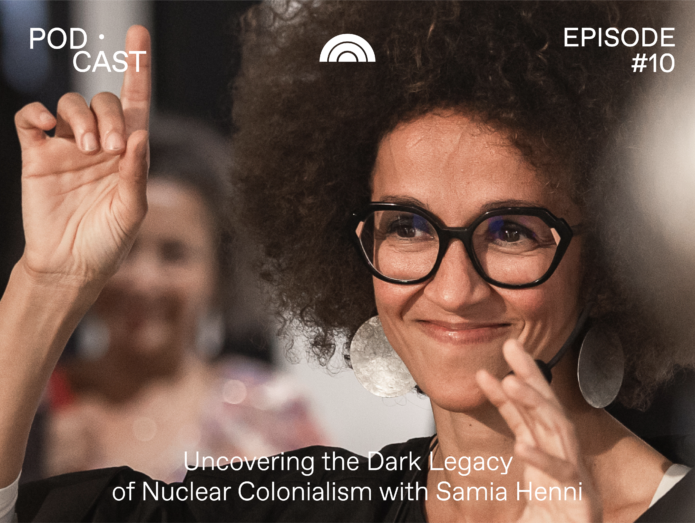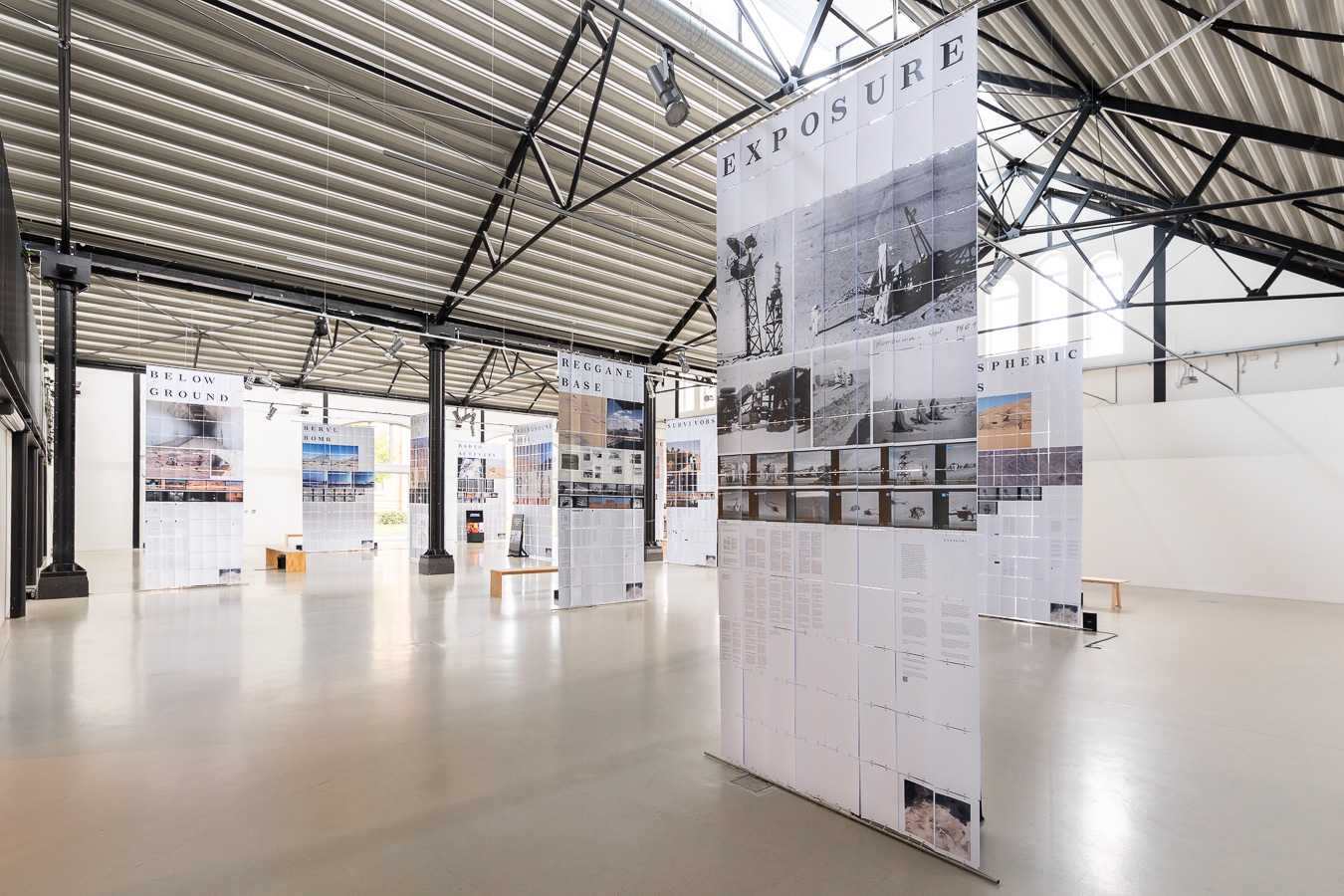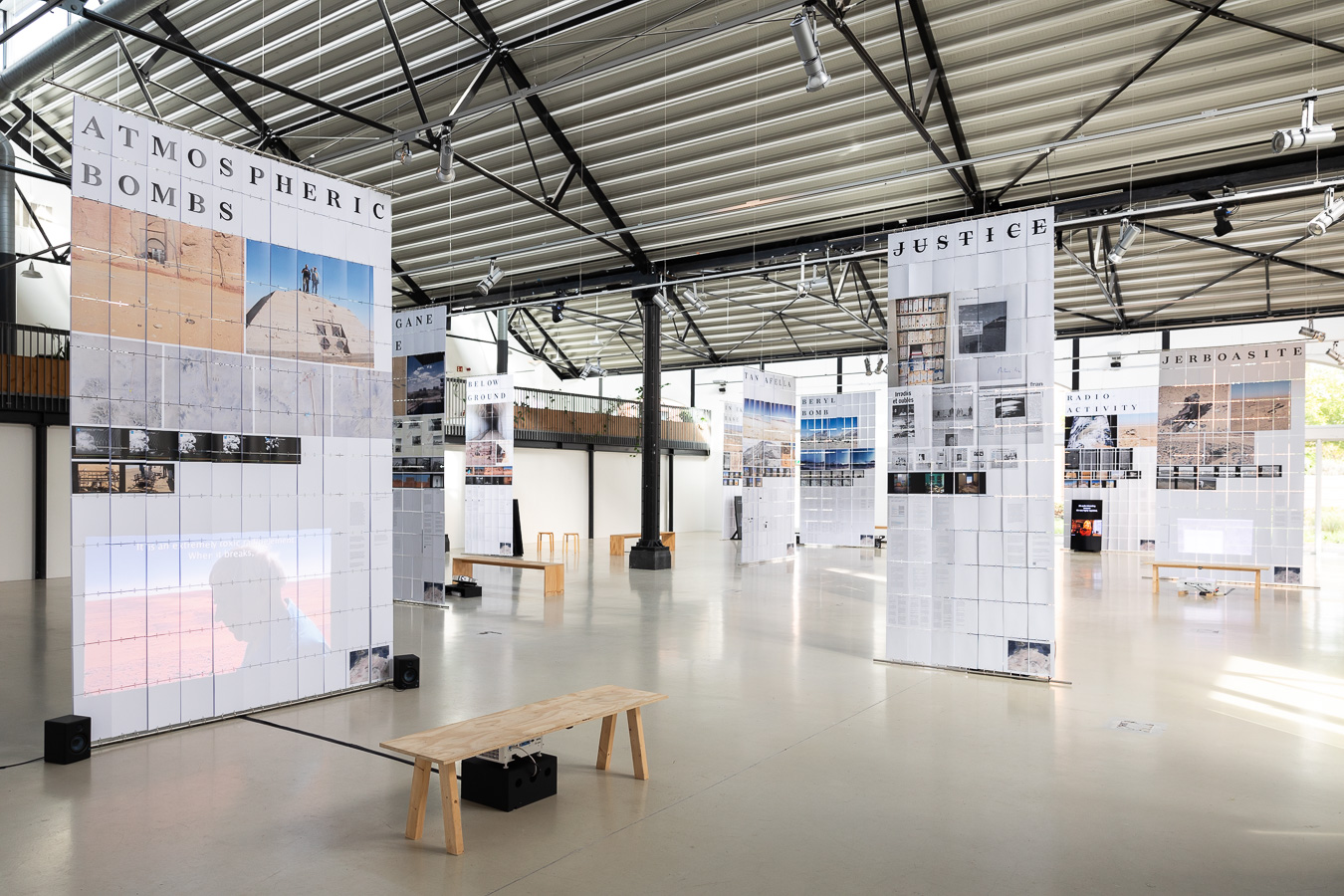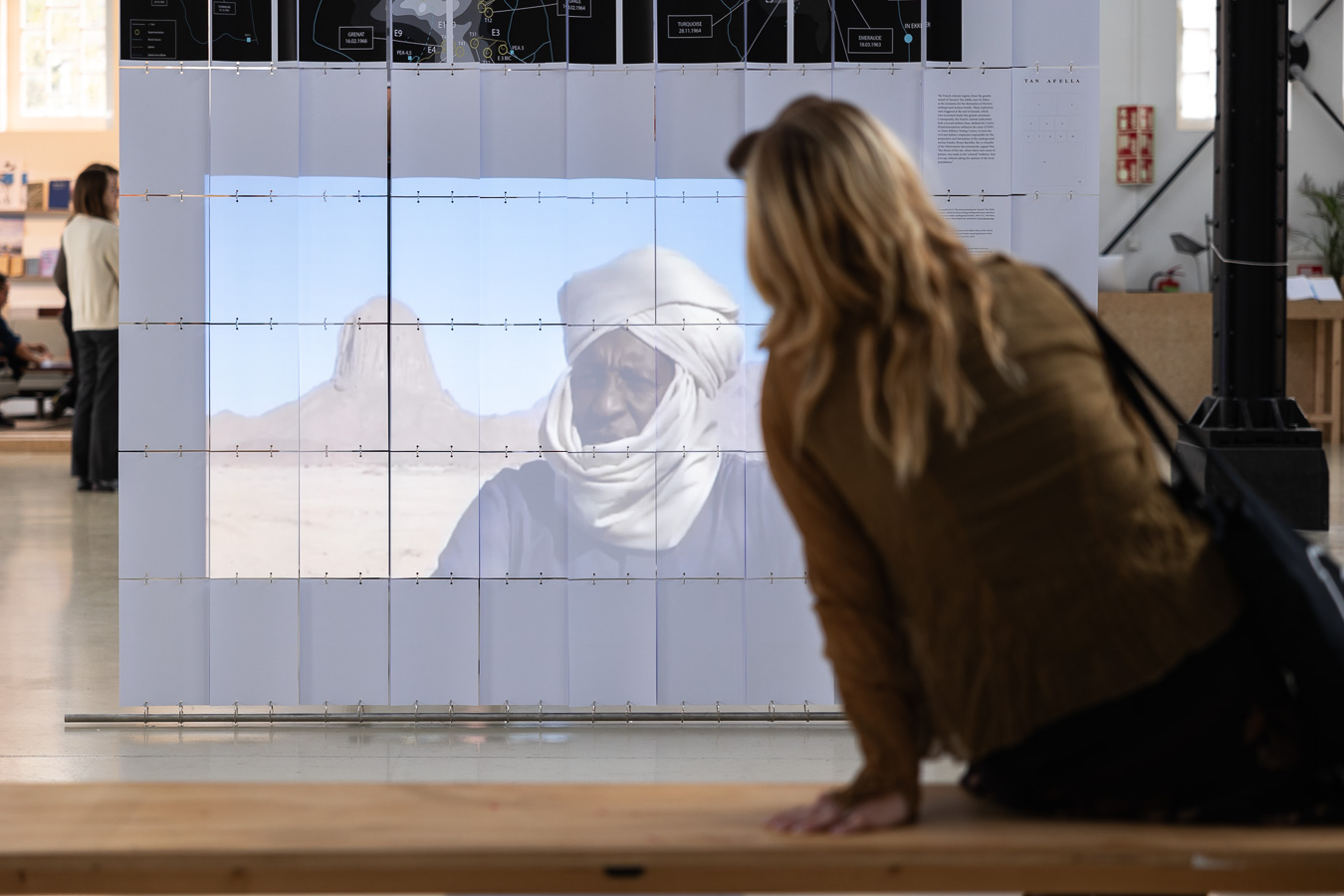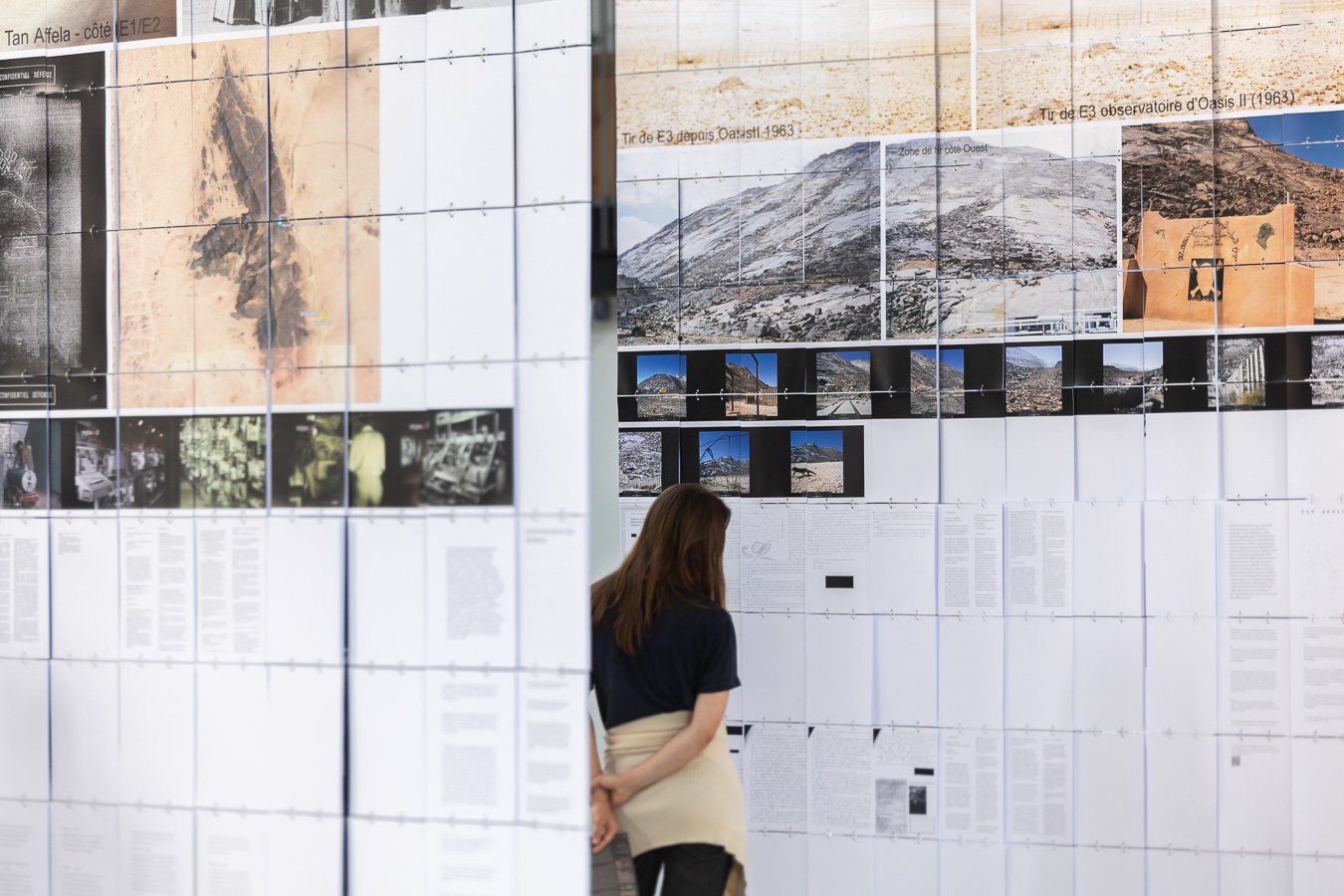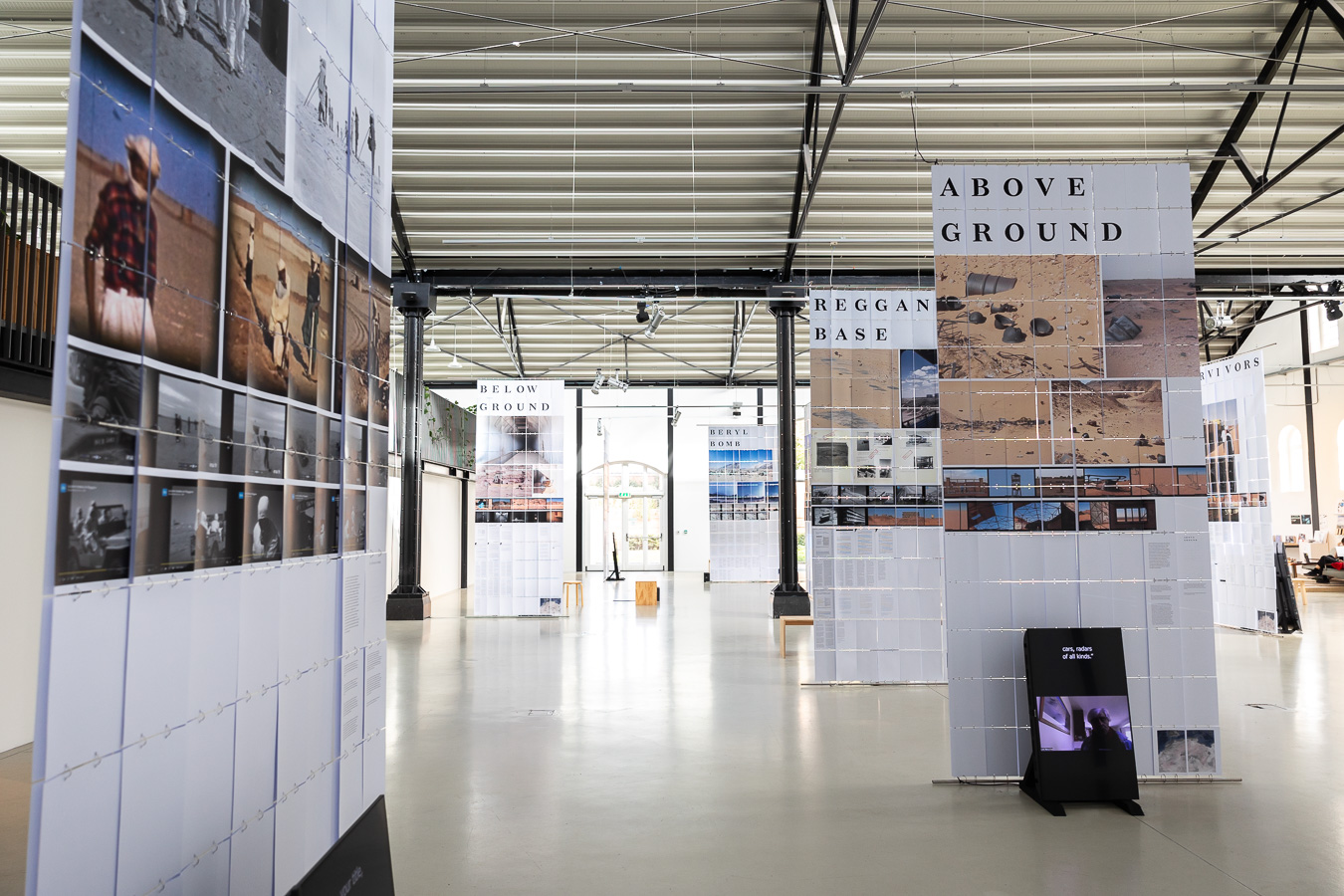8 Oct –
14 Jan 2024
Exhibition: Performing Colonial Toxicity
Framer Framed presents the exhibition Performing Colonial Toxicity by researcher and architectural historian Samia Henni, in collaboration with If I Can’t Dance, I Don’t Want To Be Part Of Your Revolution. The project sheds light on the redacted history of French nuclear colonialism in the Algerian Sahara and draws attention to the urgency of reckoning with this history and its lived environmental and sociopolitical impacts.
Between 1960 and 1966, the French colonial regime detonated four atmospheric atomic bombs, thirteen underground nuclear bombs and conducted other nuclear experiments in the Algerian Sahara, whose natural resources were being extracted in the process. This secret nuclear weapons programme occurred during and after the Algerian Revolution, or the Algerian War of Independence (1954–62). The resulting toxification of the Sahara spread radioactive fallout across Algeria, North, Central and West Africa, and the Mediterranean (including Southern Europe), causing irreversible and still ongoing contaminations of living bodies, cells and particles, as well as in the natural and built environments. Because the archives of the French nuclear programme remain closed over fifty years later, historical details and continuing impacts remain largely unknown.
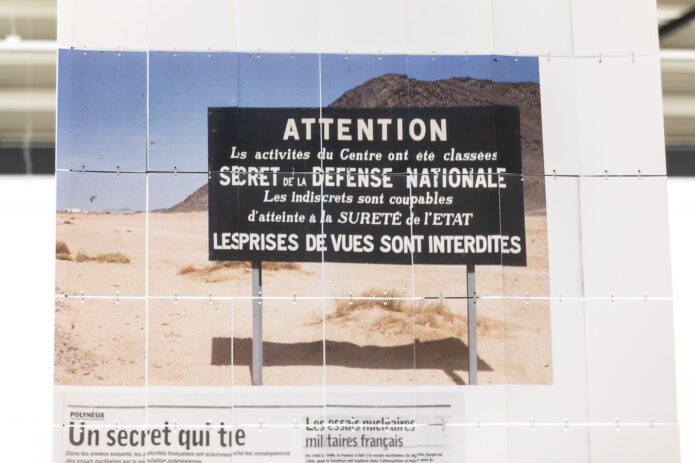
The exhibition emerges from a broader research project, which also includes the publication Colonial Toxicity: Rehearsing French Radioactive Architecture and Landscape in the Sahara (2024) and an open access digital database entitled The Testimony Translation Project.
The exhibition Performing Colonial Toxicity presents available, offered, contraband and leaked materials from these archives in an immersive multimedia installation. It creates with them a series of audio-visual assemblages, which trace the spatial, atmospheric, and geological impacts of France’s atomic bombs in the Sahara, as well as its colonial vocabularies, and the (after)lives of its radioactive debris and nuclear waste. Taking on an architectural scale, these “stations”, as Henni refers to them, are meant to be moved through and engaged with. Visitors are invited in to draw their own connections between what is present in the installation, as well as what is absent from it.
Experimenting with different methods of spatialising and circulating suppressed information, the project’s three-part structure constitutes a powerful call to action to open the still-classified archives and to clean/decontaminate the sites: both crucial steps for exposing the pasts, presents and futures of colonial toxicity.
Exhibition design & future iterations
The exhibition design and materialization takes into account a small ecological footprint for future transport and iterations, to be easily re-displayed at new locations. The exhibition travels to gta Exhibitions at ETH Zurich, Switzerland where it will be on view between March 6 and April 2, 2024. In addition, a new edition is planned at Mosaic Rooms in London, England.
Opening
Saturday 7 October, 19:00 – 21:00h
Duration
8 October – 14 January
Tuesday – Sunday, 12:00-18:00h
Free entry
Free entry, a donation at the door is appreciated
Further sources
Vent de sable by Larbi Benchiha (2008),
At(h)ome by Elisabeth Leuvrey (2016),
podcast with Samia Henni,
exhibition booklet,
Funambulist, issue 42.
Publication
Coinciding with the exhibition, Performing Colonial Toxicity (2023), Framer Framed, If Can’t Dance I Don’t Want To Be Part of Your Revolution and edition fink proudly present Colonial Toxicity: Rehearsing French Radioactive Architecture and Landscape in the Sahara (2024) a new publication by Samia Henni. This publication brings together nearly six hundred pages of materials documenting this violent history of France’s nuclear bomb programme in the Algerian desert. Meticulously culled together by the architectural historian from across available, offered, contraband, and leaked sources, the book is a rich repository for all those concerned with histories of nuclear weapons and engaged at the intersections of spatial, social and environmental justice, as well as anti-colonial archival practices. The book is presented at Framer Framed on January 14, 2024. In June 2025 the second print run will become available.
Order
You can order Colonial Toxicity: Rehearsing French Radioactive Architecture and Landscape in the Sahara (2024) through the Framer Framed webshop.
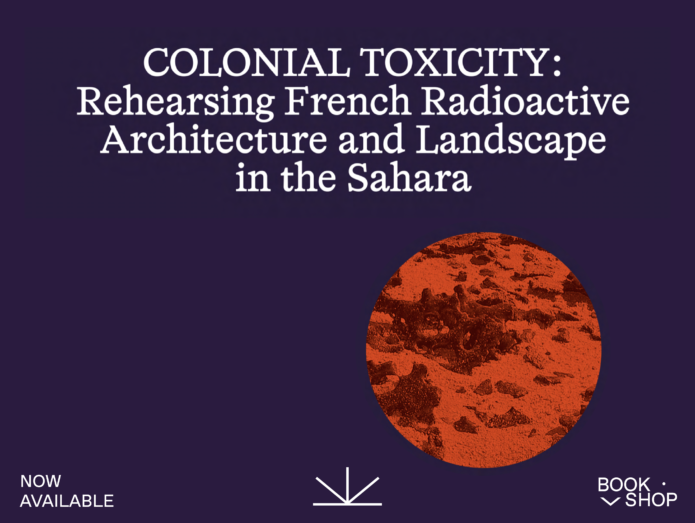
Author: Samia Henni
Managing editor: Megan Hoetger
Contributing editor: Georg Rutishauser
Copy editor: Janine Armin
Design: François Girard-Meunier
Publishers:
Framer Framed,
If I Can’t Dance,
edition fink.
592 pp,
ills col,
soft cover,
17 x 24 cm,
English, 2024, 2025
ISBN 978-90-834543-2-0
Credits
Performing Colonial Toxicity is a co-production of Framer Framed and If I Can’t Dance, I Don’t Want To Be Part Of Your Revolution. The project is supported by Swiss Arts Council Pro Helvetia. Special thanks to the Observatoire des armements, Centre de documentation et de recherche sur la paix et les conflits; the Établissement de communication et de production audiovisuelle de la Défense (ECPAD); and to filmmakers Élisabeth Leuvrey and Larbi Benchiha with producer Farid Rezkallah for use of images and film excerpts in the exhibition; as well as to Prof. Dr. Roxanne Panchasi, Simon Fraser University for her support for the Tamasheq-to-French translation of Algerian testimonies.
The exhibition is part of the two-year research project Performing Colonial Toxicity, commissioned by If I Can’t Dance, I Don’t Want To Be Part Of Your Revolution within the frame of Edition IX – Bodies and Technologies (2022-23). If I Can’t Dance is financially supported by the Mondriaan Fund, AFK, Ammodo and Prins Bernhard Cultuurfonds.
Framer Framed is supported by the Ministry of Education, Culture and Science; Amsterdam Fund for the Arts; Municipality of Amsterdam; and VriendenLoterij Fonds.
Acknowledgements
Samia Henni would like to extend her most sincere gratitude to Patrice Bouveret and the collaborators and partners of the Observatoire des armements; Larbi Benchiha, Bruno Hadjih, Elisabeth Leuvrey, Farid Rezkallah, as well as to Frédérique Bergholtz, Megan Hoetger, the extended If I Can’t Dance… team (Naomi Collier Broms, Sancha Castro, Anik Fournier, Sara Giannini, Bram Nijssen, Hans Schamlé, and Marcel van den Berg), Framer Framed team, and Swiss Art Council’s Pro Helvetia Foundation for their support of the project.
Deep thanks also go to the interviewees who have generously accepted to share their expertise and experience, including: Larbi Benchiha, Patrice Bouveret, Roland Desbordes, Bruno Hadjih, Gabrielle Hecht, Penelope Harvey, Jill Jarvis, and Roxanne Panchasi, as well as the translator-participants who have committed their time to translating Henni’s selection of testimonies, including: Raoul Audouin, Adel Ben Bella, Omar Berrada, Megan Brown, Séverine Chapelle, Simona Dvorák, Hanieh Fatouree, Alessandro Felicioli, Anik Fournier, Jill Jarvis, Augustin Jomier, Timothy Scott Johnson, Anna Jayne Kimmel, Corentin Lécine, Natasha Llorens, Miriam Matthiesen, Martine Neddam, M’hamed Oualdi, Roxanne Panchasi, and Alice Rougeaux.
And, finally, much appreciation to Marley Jaeda Barnes, Amina Belghiti, Samuel Fuchs, Floriane Germain, François Girard-Meunier, Maxime Groslambert, Pamela Hampton Hunsinger, Megan Gail Mueller, Caroline Ann O’Donnell, Roxanne Panchasi, Georg Rutishauser, Sabine Sarwa, Pascal Schwaighofer, Philip Ursprung, Oliver Wyss, Meejin Yoon, and all those who have over the years contributed to the development of this research and who asked to remain anonymous.
Image credit: Photograph by Bruno Barrillot, the co-founder of the Observatoire des armements in Lyon, France. The images were taken during a visit to France’s nuclear sites in Reggane and In Ekker in the Algerian Sahara, with the filmmaker Larbi Benchiha and his team in November 2007. Courtesy of Observatoire des armements.
- Critique d' art - Samia Henni, about Colonial Toxicity - by Kyveli Mavrokordopoulou
- e-flux - Jerboasite: Naming French Radioactive Matter in the Sahara
- ECPAD - Observatoire des armements, Centre de documentation et de recherche sur la paix et les conflits
- Metropolis M - A conversation with Samia Henni by Anna Bitkina
- Observatoire des armements / Arms Observatory
- If I Can’t Dance, I Don’t Want To Be Part Of Your Revolution
Links
- Critique d'art - Interview with Samia Henni, about Colonial Toxicity
- Performing Colonial Toxicity - Digital catalogue (EN)
- Performing Colonial Toxicity - Digital catalogue (NL)
Attachments
Contested Heritage / Ecology / The living archive / Colonial history /
Exhibitions
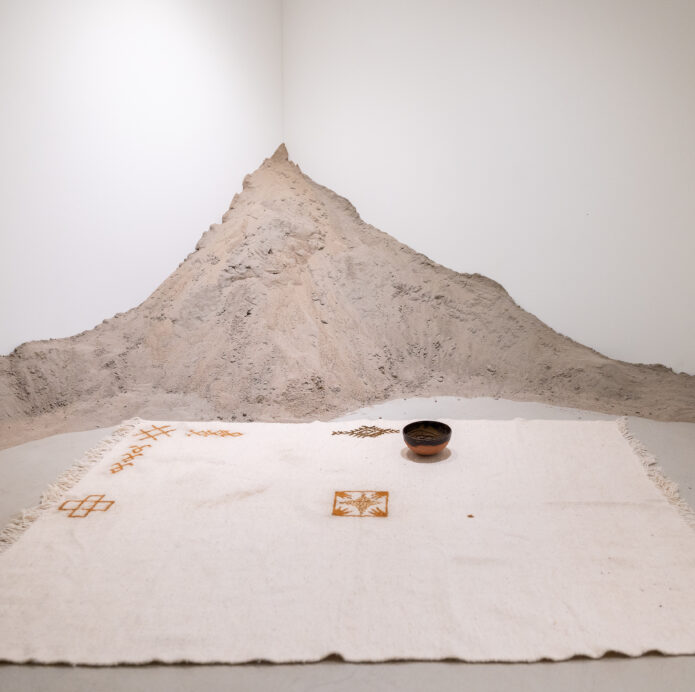
Exhibition: Amidst the Sand Wall
An exhibition by Moroccan artist 739 offering further context to the current state of the Western Sahara
Agenda
Finissage: Performing Colonial Toxicity
Finissage programme for the exhibition Performing Colonial Toxicity including a book launch of Samia Henni's newest publication.
Screening: And still, it remains
Film screening in within the context of the exhibition, Performing Colonial Toxicity.
Auction for Palestine
A collaborative fundraiser with residents from the Rijksakademie van beeldende kunsten in solidarity with Palestine
Performance Lecture by Samia Henni
In the context of her exhibition 'Performing Colonial Toxicity' now on show at Framer Framed
Performing Colonial Toxicity Tour: The Testimony Translation Project
Guided tour reflecting on the testimony translations
Opening: Performing Colonial Toxicity
An exhibition by researcher Samia Henni on the redacted history of French nuclear colonialism in the Algerian Sahara
Network
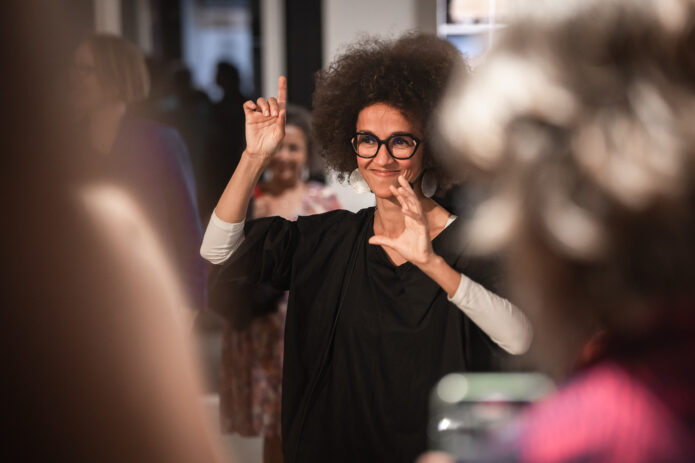
Samia Henni
Architectural historian, Exhibition-maker
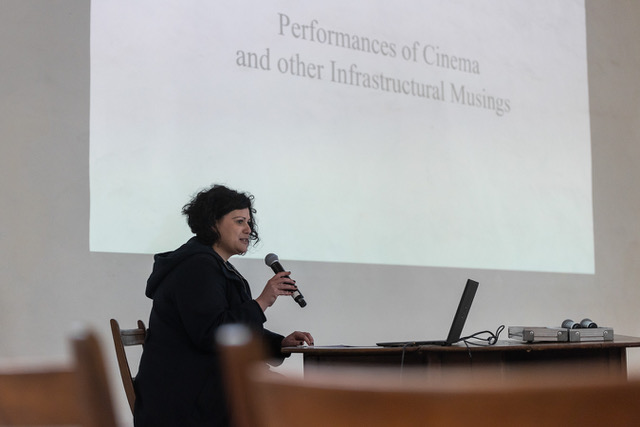
Megan Hoetger
Curator, Researcher
Magazine


Performing Colonial Toxicity travels to Zurich, London and Paris

Bookshop Selection: Colonial Toxicity by Samia Henni
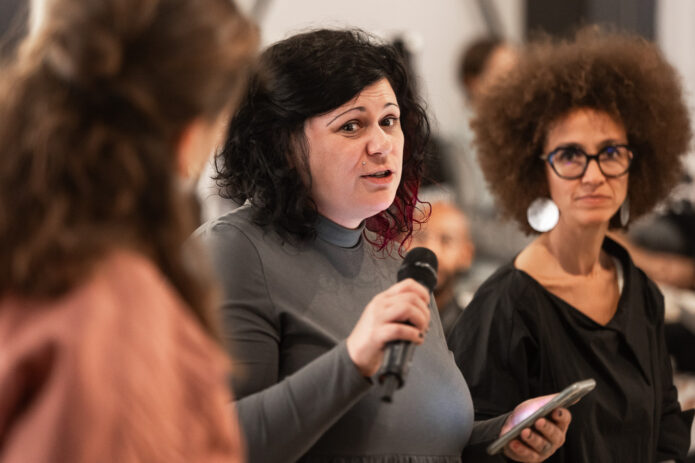
Video: Megan Hoetger in conversation with Samia Henni
